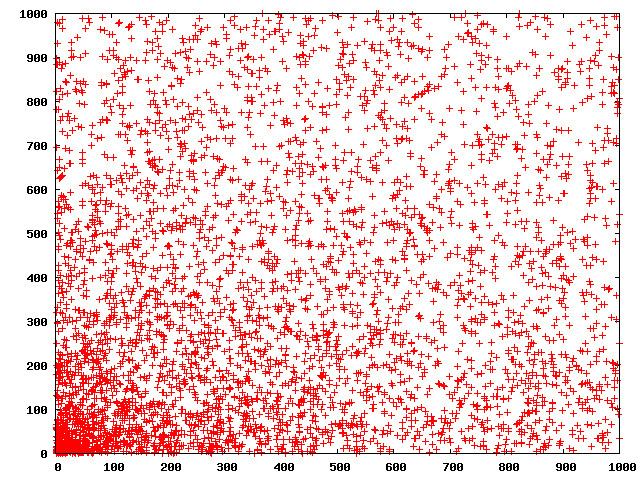 | ||
A Pierpont prime is a prime number of the form
Contents
- Distribution
- Primality testing
- Pierpont primes found as factors of Fermat numbers
- Polygon construction
- Generalization
- References
for some nonnegative integers u and v. That is, they are the prime numbers p for which p − 1 is 3-smooth. They are named after the mathematician James Pierpont, who introduced them in the study of regular polygons that can be constructed using conic sections.
It is possible to prove that if v = 0 and u > 0, then u must be a power of 2, making the prime a Fermat prime. If v is positive then u must also be positive, and the Pierpont prime is of the form 6k + 1 (because if u = 0 and v > 0 then 2u3v + 1 is an even number greater than 2 and therefore composite).
The first few Pierpont primes are:
2, 3, 5, 7, 13, 17, 19, 37, 73, 97, 109, 163, 193, 257, 433, 487, 577, 769, 1153, 1297, 1459, 2593, 2917, 3457, 3889, 10369, 12289, 17497, 18433, 39367, 52489, 65537, 139969, 147457, 209953, 331777, 472393, 629857, 746497, 786433, 839809, 995329, ... (sequence A005109 in the OEIS)Distribution
Empirically, the Pierpont primes do not seem to be particularly rare or sparsely distributed. There are 36 Pierpont primes less than 106, 59 less than 109, 151 less than 1020, and 789 less than 10100. There are few restrictions from algebraic factorisations on the Pierpont primes, so there are no requirements like the Mersenne prime condition that the exponent must be prime. Thus, it is expected that among n-digit numbers of the correct form
Andrew M. Gleason made this reasoning explicit, conjecturing there are infinitely many Pierpont primes, and more specifically that there should be approximately 9n Pierpont primes up to 10n. According to Gleason's conjecture there are Θ(log N) Pierpont primes smaller than N, as opposed to the smaller conjectural number O(log log N) of Mersenne primes in that range.
Primality testing
When
Pierpont primes found as factors of Fermat numbers
As part of the ongoing worldwide search for factors of Fermat numbers, some Pierpont primes have been announced as factors. The following table gives values of m, k, and n such that
The left-hand side is a Pierpont prime when k is a power of 3; the right-hand side is a Fermat number.
As of 2017, the largest known Pierpont prime is 3 × 210829346 + 1, whose primality was discovered by Sai Yik Tang and PrimeGrid in 2014.
Polygon construction
In the mathematics of paper folding, the Huzita axioms define six of the seven types of fold possible. It has been shown that these folds are sufficient to allow the construction of the points that solve any cubic equation. It follows that they allow any regular polygon of N sides to be formed, as long as N > 3 and of the form 2m3nρ, where ρ is a product of distinct Pierpont primes. This is the same class of regular polygons as those that can be constructed with a compass, straightedge, and angle-trisector. Regular polygons which can be constructed with only compass and straightedge (constructible polygons) are the special case where n = 0 and ρ is a product of distinct Fermat primes, themselves a subset of Pierpont primes.
In 1895, James Pierpont studied the same class of regular polygons; his work is what gives the name to the Pierpont primes. Pierpont generalized compass and straightedge constructions in a different way, by adding the ability to draw conic sections whose coefficients come from previously constructed points. As he showed, the regular N-gons that can be constructed with these operations are the ones such that the totient of N is 3-smooth. Since the totient of a prime is formed by subtracting one from it, the primes N for which Pierpont's construction works are exactly the Pierpont primes. However, Pierpont did not describe the form of the composite numbers with 3-smooth totients. As Gleason later showed, these numbers are exactly the ones of the form 2m3nρ given above.
The smallest prime that is not a Pierpont (or Fermat) prime is 11; therefore, the hendecagon is the smallest regular polygon that cannot be constructed with compass, straightedge and angle trisector (or origami, or conic sections). All other regular N-gons with 3 ≤ N ≤ 21 can be constructed with compass, straightedge and trisector.
Generalization
A Pierpont prime of the second kind is a prime number of the form 2u3v − 1, they are
2, 3, 5, 7, 11, 17, 23, 31, 47, 53, 71, 107, 127, 191, 383, 431, 647, 863, 971, 1151, 2591, 4373, 6143, 6911, 8191, 8747, 13121, 15551, 23327, 27647, 62207, 73727, 131071, 139967, 165887, 294911, 314927, 442367, 472391, 497663, 524287, 786431, 995327, ... (sequence A005105 in the OEIS)A generalized Pierpont prime is a prime of the form
